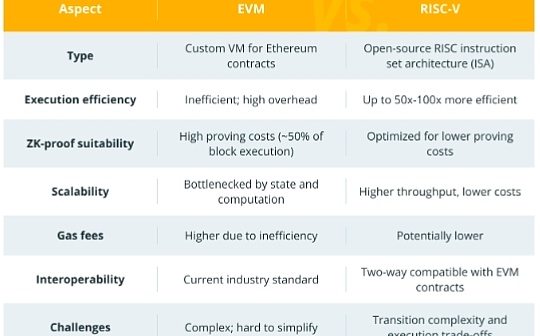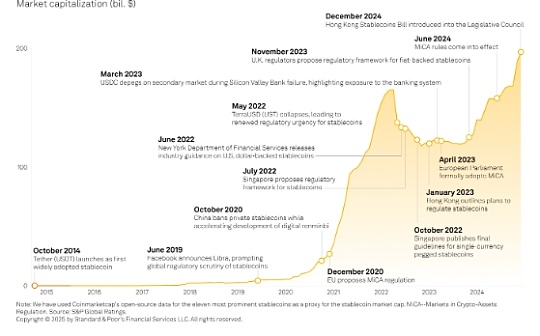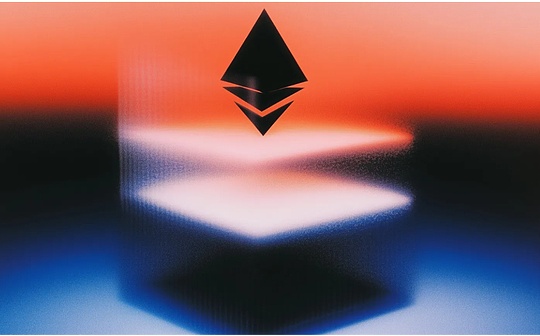
Author: Marcel Deer, CoinTelegraph; Compilation: Baishui, Bitchain Vision
1. What is RISC-V?
RISC-V, pronounced as “risk five”, is a modern open source instruction set architecture (ISA) based on the principle of streamlined instruction set computers (RISC).Simply put, it is like a blueprint that defines a set of instructions that a processor can execute.
The RISC-V is designed to be highly modular, efficient and flexible.Originally developed by the University of California in 2010, the open source framework gives developers the flexibility to customize their features and use cases, and also saves costs compared to proprietary ISAs such as ARM or x86.RISC-V is widely used, from supercomputers to smartphones, and now blockchains such as Ethereum.
On April 20, 2025, Ethereum co-founder Vitalik Buterin announced a “radical” new expansion solution that will replace Ethereum virtual machines (EVMs) with the RISC-V instruction set architecture, aiming to improve the speed and efficiency of the network execution layer.The idea is that RISC-V is the best solution to the limitations of blockchain scalability.
“It aims to significantly improve the efficiency of the Ethereum execution layer, solve one of the major expansion bottlenecks, and significantly improve the simplicity of the execution layer—in fact, this may be the only viable solution.”
The idea is to replace EVM with RISC-V as a virtual machine language for writing smart contracts,” Buterin said.
As users turn to Layer 2 for cheaper and faster transactions, Ethereum continues to face high transaction fees and decline in transaction volume.This is consistent with Ethereum’s scaling strategy after its merger in 2022.Buterin’s idea of reshaping Ethereum is seen as an opportunity to modernize Ethereum and maintain its dominance as a top smart contract platform.
2. How does RISC-V run on Ethereum?
Adding RISC-V to Ethereum is still only a proposal under discussion for community and network governance.Buterin outlines several ways to implement the proposal, including running two virtual machines (VMs) or switching to RISC-V completely.
The first idea for supporting virtual machines is to allow contracts to be written and executed in an existing EVM model or RISC-V.Both contract types can access functions such as persistent storage, holding Ether balances, and initiating and receiving calls.In addition, contracts can be integrated to call each other.
Another option known as “more radical” is to modify the protocol to convert existing EVM contracts.This requires rewriting the existing contract to interact with the EVM interpreter, while the new contract is written directly in RISC-V.
One of the major challenges facing such a major change is to avoid breaking existing decentralized applications (DApps) and smart contracts.Ethereum cannot risk breaking existing contracts written in current EVM code.A transitional solution might involve using an interpreter—essentially a conversion layer between different computing languages.This will allow developers to start building with RISC-V while ensuring that traditional EVM contracts continue to run without interruption.
3. The main advantages of RISC-V and EVM
If RISC-V leads to a major shift in the Ethereum architecture, what benefits will this shift bring?In the long run, RISC-V will improve the performance and processing power of Ethereum smart contracts.
According to Buterin, the new architecture can theoretically achieve a 100-fold increase in efficiency; in fact, this number is difficult to achieve, but the improvement is still very significant.Efficiency improvement is closely related to the applicability of RISC-V to zero-knowledge (ZK) proof systems and general-purpose smart contract execution, as it eliminates the overhead of EVM.
Rather than completely replacing EVM, RISC-V uses RISC-V as the backend for zkEVM or similar ZK Rollup, because in these systems, proven costs dominate.The improvement in scalability mainly comes from moving execution tasks to ZK Rollup, while RISC-V optimizes the proof process.

RISC-V smart contracts can run faster and consume less computing resources.This efficiency improvement is likely to translate into a reduction in Gas expenses for the end user.In the process, it also enables the network to process more users and transactions without slowing down speed.This will directly improve the scalability of Ethereum and hopefully solve one of the most criticized problems in the blockchain industry.
In addition, RISC-V’s simple and flexible instruction set is more suitable for zero-knowledge proof computing than EVM, because EVM can incur overhead for management tasks such as Gas accounting and state management.
Rather than rebuilding EVMs to support zero-knowledge proofs, RISC-V provides a streamlined alternative that simplifies the development of zero-knowledge optimization execution layer.This can accelerate Ethereum’s roadmap for privacy and scalability through Zero Knowledge Summary (ZK Rollup), making RISC-V a powerful complement to EVM.
The following table summarizes the main differences and advantages of RISC-V and EVM.

4. Will RISC-V be implemented in the future?
Buterin’s proposal has sparked heated debate among Ethereum users and developers.This is an ambitious idea that could be a milestone on the roadmap for leading smart contract blockchain development.
Programmer Ben Adams raised several concerns about the proposal: In short, zero-knowledge proofs may become more efficient, but there may be some disadvantages.Block build and execution that runs smart contracts may end up being significantly slower.
“The risk here is that zero-knowledge proofs may get better, but block construction and execution will deteriorate significantly,” commented Ben Adams.
Another anonymous commenter expressed the same view: “I agree with Ben Adams that EVM is based on the U256 architecture as a whole, so abstracting to RISC-V will degrade overall execution performance.”
Others also seem to agree that RISC-V is a good idea to help reduce bottlenecks, but given the potential technical difficulty and cost, they question whether it should be prioritized.
“Agree, it seems like a good idea to solve points 2 and 3 of the Layer-1 bottleneck. But is this a problem we want to prioritize? Especially considering the scale of the technology costs?” Adam Cochran added.
Obviously, the proposal still needs further clarification and requires further discussion by the Ethereum community.While the proposal promises to completely simplify the process to increase efficiency and speed, it also introduces a complex technological change.It may take years to rethink how the Layer-1 blockchain works.
Of course, like any decentralized project, approval for approval is not just about technical planning; it requires community approval.Therefore, at present, Buterin’s proposal has sparked extensive discussions about any upcoming development actions.








